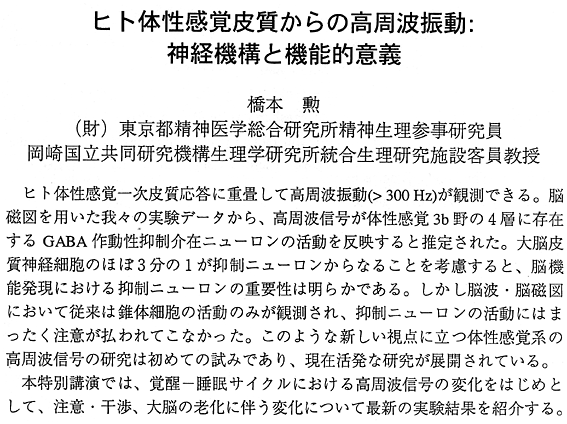High-frequency oscillations from the human somatosensory cortex:
Neural mechanisms and functional significance
Isao HashimotoTokyo Institute of Psychiatry, Setagaya-ku, Tokyo 156-8585, and National Institute for Physiological Sciences, Okazaki, Japan
There has been a remarkable resurgence of interest in high-frequency oscillations (> 300 Hz) from the human somatosensory cortex in recent years. This is mainly because of a high level of expectation to record noninvasively not only excitatory postsynaptic potentials (EPSPs) of the pyramidal neurons in the somatosensory cortex but also action potentials of the thalamocortical projection fibers [1, 2]. Moreover, it is also possible that the somatic evoked high-frequency oscillations represent activity of GABAergic inhibitory interneurons controlling the output of pyramidal cells in the cortex [3]. The possibility to observe activity not only from the thalamocortical afferent fibers but also from cortical interneurons widens the type of signals which can be measured with electroencephalography (EEG) and magnetoencephalography (MEG) and thus expands the application of EEG and MEG. This will have a great impact on clinical studies.
Thalamocortical axons entering the cortex and interneurons in different layers of the cortex constitute two of the three important neural elements in cortical micro-circuitry. In this lecture, a quick review of previous studies is given on somatic evoked high-frequency oscillations. Then, we describe briefly our recent data on detection of high-frequency oscillations to posterior tibial nerve stimulation and also on both tangential (area 3b) and radial (area 1) dipole orientations to median nerve stimulation [4]. Our findings show that high-frequency oscillations are not specific to median nerve stimulation but represent ubiquitous activity in the primary somatosensory cortex (areas 3b and 1). Thirdly, modulation of high-frequency oscillations versus N20(m) primary response by a wake-sleep cycle [3], by attention or interference, and by aging are also presented. Finally, our GABAergic inhibitory interneuron hypothesis for the high-frequency oscillations is proposed, primarily on the basis of our findings on reciprocal modulation of the high-frequency oscillations and the underlying N20(m) by a wake-sleep cycle and by attention or interference.
Supported by the Ministry of Education, Science and Culture of Japan Grants Nos. 05404087 and 09877185.
- Curio, G., Mackert, B.M., Burghoff, M., Koetitz, R., Abraham-Fuchs, K., and Härer, W. Electroenceph. Clin. Neurophysiol. 91: 483-487, 1994
- Gobbelé, R., Buchner, H., and Curio, G. Electroenceph. Clin. Neurophysiol. 108: 182-189, 1998
- Hashimoto, I., Mashiko, T., and Imada, T. Electroenceph. Clin. Neurophysiol. 100: 180-203, 1996
- Ozaki, I., Suzuki, C., Yaegashi, Y., Baba, M., Matsunaga, M., and Hashimoto, I. Electroenceph. Clin. Neurophysiol. (in press)

